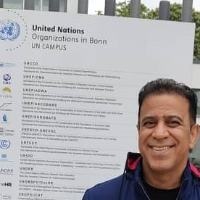A Study of the Performance of the Algerian States in Drawing the Base Lines: Clarification the Convention on the Law of the Sea 1982 article 47
Background and Theoretical Foundations:
Approximately 7% of the total land area consists of islands that are arched, rectangular, triangular and quasi-geometric patterns in various water zones. A few of these islands are divided into groups, forming the "archipelago between the oceans" and the "archipelago countries", and this diversity has led geographers to consider each group of islands as a unique combination. The rules of the seas and oceans have played a very important role in ensuring maritime security and order for centuries, but today, thanks to military, scientific and legal development, the need to conceptualize and explain new concepts governing the law of the sea is increasingly felt. The exercise of state authority over maritime areas has long been a vital and crucial issue, and the principle of territorial jurisdiction in domestic territory is an accepted concept in customary international law, but the rules of customary international law in the field of seas are not effective enough to realize the rights of archipelago countries. These customary rules did not provide sufficient practical and legal guarantees for the Algerian governments to access mineral resources, energy fields and fisheries.While delimiting the maritime borders subject to the drawing of "lines of origin" is necessary to determine the width of the "territorial sea" and other maritime regions, the drawing of the lines of origin of the Algerian countries was associated with more challenges. Finally, the 1982 Convention on the Law of the Sea responded to the doubts and, while presenting the definition of the country of the Algerian Assembly, allowed the drawing of the line of origin of the Algerian Assembly if the legal conditions are met in such countries. Now the question arises, how did the efforts of the Algerian countries to realize the rights of fraud in the waters of the Algerian waters pave the way for the drafting of the fourth chapter of the 1982 Convention on the Law of the Sea? And to what extent has the practice of the Algerian states in drawing the lines of origin followed the rules of the Convention?
This descriptive-analytical study, after an overview of the types of baselines, has discussed the possibility of drawing the baseline of the Algerian archipelago or the right to maintain and establish these lines with reference to the 1982 Convention on the Law of the Sea.
The findings of this study indicate that the identification of the legal status of the Algerian countries since 1920 has been the subject of intensive studies in the field of territorial waters. However, prior to the ruling of the International Court of Justice in the Fisheries case of England / Norway (1951), the drawing of the baselines of such countries was in a state of ambiguity. Given that it is possible to determine the width of maritime zones by describing how to draw baselines, the legal challenges of the archipelago countries to delineate baselines, delimit maritime zones and control inter-island waters continued until the 1982 Convention on the Law of the Sea. The Articles 46 and 47 of the 1982 Convention on the Law of the Sea, while defining the concept of the archipelago and explaining how to draw the lines of origin of the archipelago, put an end to years of confusion for international law.
This study examines among the many ambiguous factors that the Algerian country can face and concludes that the issues of how to draw the baseline are more controversial than any other topic, because baselines are the starting point for measuring maritime boundaries and determining The boundaries of overlapping areas with neighboring and neighboring countries. Of course, the legislative silence prior to the 1982 Convention on the Law of the Sea and the lack of a special solution for the Algerian archipelago never prevented them from applying a similar procedure relying on the International Court of Justice in the England / Norway (1951) fisheries case and connecting their islands to direct lines of origin. And to abandon the claim of the need to pass special rules for the drawing of baselines for island territories. However, Article 47 of the Convention sets out a set of objective rules for delineating the archipelago, two of which have a numerical approach (water-to-land ratio / maximum length of baseline) to prevent arbitrary procedures in countries such as the United Kingdom and Australia. And Cuba is legislated for the increasing development of maritime space. Paragraphs 3, 4, 5 of Article 47, with a qualitative approach, indicate the need to observe the conditions for drawing a direct line of origin in drawing the starting line of the Algerian Assembly. The legal status of the countries of the Algerian Assembly. Therefore, the 1982 Convention, according to Articles 46 and 47, was able to provide a correct definition of the concept of the archipelago, how to draw the lines of origin of the archipelago, and finally this study concluded that the possibility of drawing the line of origin of the archipelago or the right to preserve and establish these lines Relying on the 1982 Convention on the Law of the Sea is enforceable, and a study of the practice of the Algerian States has shown that all Algerian States have so far drawn their lines of origin in accordance with the provisions of Article 47.
- حق عضویت دریافتی صرف حمایت از نشریات عضو و نگهداری، تکمیل و توسعه مگیران میشود.
- پرداخت حق اشتراک و دانلود مقالات اجازه بازنشر آن در سایر رسانههای چاپی و دیجیتال را به کاربر نمیدهد.


